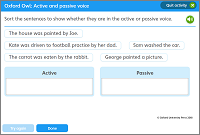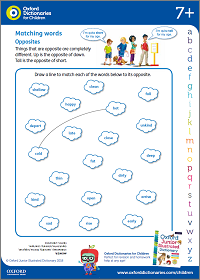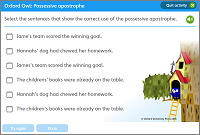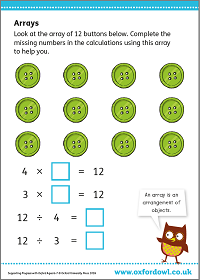Jargon buster: 'Adverbials' to 'arrays'

A | B–C | D–G | H–L | M | N–O | P | Q–R | S | T–Z
A | B | C | D | E | F | G | H | I | J | K | L | M | N | O | P | Q | R | S | T | U | V | W | X | Y | Z
A
Active voice
In a sentence with an active verb, the subject of the verb is doing the action. This is called the active voice.
For example: Hilda strode into the goal area.
Video: What are active and passive sentences?
Activity:
Grammar: Active and passive voice (Age 10–11)

Practice: You'll find more activities on our Kids' activities page >
Adjective
An adjective gives more information about a noun. It often goes before the noun or after the verb 'to be' ('is', 'am', 'are', 'was', 'were', and so on).
For example: The little, green bird pecked the juicy apple. The apple was delicious.
Adverb
An adverb gives more information about a verb, an adjective, another adverb or a clause. An adverb tells you how, when, where or how often something happens.
For example: Later, a cat crept up the tree as the little green bird eagerly pecked the juicy apple twice and ate it noisily.
Some adverbs make a comment or link ideas.
For example: Fortunately, we won. However, the other team played well.
Some adverbs are used to say how likely or possible something is.
For example: We’ll definitely come to the party.
Some adverbs are used for emphasis.
For example: The bag was terribly heavy.
Adverbial
A word or phrase that gives more information about a verb or clause. An adverbial can be an adverb, a phrase or a subordinate clause.
For example: The bird ate the apple noisily.
For example: The cat sleeps all day.
For example: We’ll play when we get home.
Fronted adverbials are adverbials placed at the beginning of a sentence. There is usually a comma after a fronted adverbial. Watch our short animation for more information.
Video: What are fronted adverbials?
Alphabetic code
This code shows us the relationship between the sounds of our speech (phonemes) and the written letter(s) of the alphabet and how these are used to match those sounds.
Ambiguity
When something has more than one possible meaning.
For example: ‘I hate annoying people.’
This could mean ‘I do not like to annoy people’ or ‘I do not like people who are annoying’.
Another example: ‘It is a large furniture shop.’
This could mean ‘It is a shop which sells large furniture’ or ‘It is a large shop which sells furniture’.
Antonym
Words that mean the opposite of each other, such as wet and dry, full and empty, open and closed. The opposite of an antonym is a synonym.
Video: What are synonyms and antonyms?
Activity: Opposites (Ages 7+)

Apostrophe '
An apostrophe can be used to show when a word has been made shorter by dropping one or more letters. This is called a contraction. You usually use contractions in informal writing or when writing direct speech.
For example:
I am = I’m
did not = didn’t
could not = couldn’t
we are = we’re
you have = you’ve
she will/she shall = she’ll
An apostrophe can also show ownership or possession. This is called a possessive apostrophe. Possessive apostrophes show that something belongs to, or is for, someone or something. Often, a possessive apostrophe is used with a possessive s.
If a singular word doesn’t end in -s, add ’s:
For example: the boy’s pen.
If a singular word ends in -s, add either ’s or just ’:
For example: James’s hat; Nicholas’ hat.
If a singular word ends in -ss, still add ’s:
For example: the princess’s crown.
If a plural ends in -s, just add ’:
For example: the girls’ bags; the visitors’ car park; the calves’ horns.
If a plural doesn’t end in -s, add ’s:
For example: men’s coats.
Video: How to use apostrophes
Activity: Grammar: Possessive apostrophe (Age 7–8)

Array
Shapes or objects arranged in a rectangle are called an array. Egg boxes or muffin trays are good examples of arrays. Teachers use these to help children to 'see' multiplication. For example, if you have a tray of muffins that is four muffins along and three muffins deep, there will be twelve muffins in total.
Activity: Multiplication and division (Age 6–7)

Article
The words 'the', 'an' and 'a' are called articles. They are a type of determiner.
Definite article:The determiner 'the' is the definite article.
For example: The book is on the table.Indefinite article:
The determiner 'a/an' is the indefinite article.
For example: Bring me a book.
Averages
When we talk about averages in everyday life, we are usually referring to the mean average. This is the sum of the numbers in a set of data, divided by the number of members of that set. So if we wanted to know the average age of a group of children, we would add up all their ages and divide by the number of children.
There are two other types of average that children may come across in maths. They are:
Median average: The number in the middle if you place the numbers in a set in order of size.
Mode average: The most common number in a set (if any of the numbers occur more than once).
Video: What are averages?
A | B–C | D–G | H–L | M | N–O | P | Q–R | S | T–Z
A | B | C | D | E | F | G | H | I | J | K | L | M | N | O | P | Q | R | S | T | U | V | W | X | Y | Z